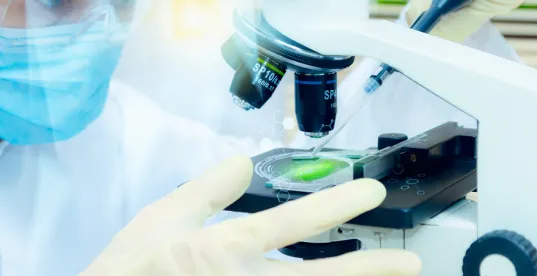In Genetic Veterinary Sciences, Inc. v. Laboklin GMBH & Co., the Federal Circuit upheld the district court decision that held claims directed to methods for genotyping a Labrador Retriever invalid under 35 USC § 101 at the JMOL stage. Sadly, the court’s discussion of personal jurisdiction issues may be more interesting than the all-to familiar explanation of why diagnostic methods are not eligible for patenting under the Supreme Court’s Alice/Mayo framework.
The Patent At Issue
The patent at issue was U.S. Patent No. 9,157,114, entitled “Method of determining the genotype relating to hereditary nasal parakeratosis (HNPK) and nucleic acids usable in said method.” The Federal Circuit considered claims 1-3:
-
An in vitro method for genotyping a Labrador Retriever comprising: a) obtaining a biological sample from the Labrador Retriever; b) genotyping a SUV39H2 gene encoding the polypeptide of SEQ ID NO: 1 and c) detecting the presence of a replacement of a nucleotide T with a nucleotide G at position 972 of SEQ ID NO: 2.
-
The method according to claim 1, wherein the genotyping is achieved by PCR, real-time PCR, melting point analysis of double-stranded DNA, mass spectroscopy, direct DNA sequencing, restriction fragment length polymorphism (RFLP), single strand conformation polymorphism (SSCP), high performance liquid chromatography (HPLC), or single base primer extension.
-
The method of claim 1, wherein the genotyping utilizes a primer pair comprising a first primer and a second primer, each comprising a contiguous span of at least 14 nucleotides of the sequence SEQ ID NO: 2 or a sequence complementary thereto, wherein: a) said first primer hybridizes to a first DNA strand of the SUV39H2 gene; b) said second primer hybridizes to the strand complementary to said first DNA strand of the SUV39H2 gene; and c) the 3' ends of said first and second primers are located on regions flanking the position 972 of SEQ ID NO: 2, or of nucleotide positions complementary thereto.
While not recited in the claims, the patent explains that the recited mutation is associated with hereditary nasal parakeratosis (HNPK) which occurs in Labrador Retrievers.According to the patent, the invention permits breeders to genotype Labrador Retrievers and “eliminate carriers from breeding programs.”
The Personal Jurisdiction Issues
The patent is owned by the University of Bern (a Swiss entity) and exclusively licensed to Laboklin (a German company), each of which challenged the district court’s personal jurisdiction.
The Federal Circuit evaluated personal jurisdiction over Laboklin under Federal Rule of Civil Procedure 4(k)(2), focusing on the Constitutional due process requirement. As noted by the court, the test for compliance with due process is whether the “nonresident defendant” has “certain minimum contacts with [the forum] such that the maintenance of the suit does not offend traditional notions of fair play and substantial justice.” Here, the relevant “forum” for assessing “minimum contacts” is the U.S. as a whole, not just “the state in which the district court sits.”
The Federal Circuit explained the personal jurisdiction question as a three-part test:
-
whether the defendant purposefully directed its activities at residents of the forum;
-
whether the claim arises out of or relates to the defendant’s activities with the forum; and
-
whether assertion of personal jurisdiction is reasonable and fair.
As to Laboklin, the Federal Circuit found that its sending of a cease-and-desist letter to PPG in the U.S. and commercial licensing activities with regard to the patent at issue satisfied prongs (1) and (2) and supported personal jurisdiction. The court found prong (3) satisfied because Laboklin had “purposefully availed itself of the benefits and protections of U.S. laws through its commercial sublicensing as well as its enforcement of a U.S. patent.”
The Federal Circuit evaluated personal jurisdiction over the University under the Foreign Sovereign Immunities Act (FISA). The court noted that, under FISA, engaging in commercial activity can give rise to an exception to sovereign immunity:
The University cannot claim immunity in the District Court because it obtained a U.S. patent and then participated in licensing and enforcing the ’114 patent, which constitutes “commercial activity” under the FSIA.
In this regard, the Federal Circuit noted that, consistent with the license agreement with Laboklin, the University had consented to the cease-and-desist letter and “ultimately controlled enforcement of the ’114 patent.”
The Patent Eligibility Issue
The Federal Circuit approached the patent eligibility analysis by comparing its previous decisions in Arisosa v. Sequenomand CellzDirect.Unfortunately for the patent holder, it found the claims at issue to be more akin to those invalidated in Ariosa than those upheld in CellzDirect:
Taken together, the plain language of claim 1 demonstrates that it is directed to nothing more than “observing or identifying” the natural phenomenon of a mutation in the SUV39H2 gene. …. Claims 2 and 3 depend from independent claim 1 and add only generic methods of detecting the natural phenomenon. Thus, the Asserted Claims are directed to natural phenomenon at Alice step one.
*****
The Asserted Claims do not recite an inventive concept that transforms the observation of a natural phenomenon into a patentable invention. Nothing in claim 1’s language suggests the invention of a new method for genotyping.
*****
[A]ny reliance on CellzDirect is misguided. As we stated above, the claims at issue in CellzDirect were directed to a “new and improved technique[] for producing a tangible and useful result,” i.e., preserving those cells for later use. …. Here, the Asserted Claims provide no tangible result save the observation and detection of a mutation in a dog’s DNA. While a positive and valuable contribution, these claims fall short of statutory patentable subject matter.
Thus, the Federal Circuit affirmed the district court decision holding the claims invalid under § 101.
Will Congress Act To Provide Patentability For Diagnostics?
The last sentences of the court’s analysis drives home the need for Congressional action in order to make patent protection available to promote investment in the development and validation of diagnostic methods.
While a positive and valuable contribution, these claims fall short of statutory patentable subject matter.




 />i
/>i
